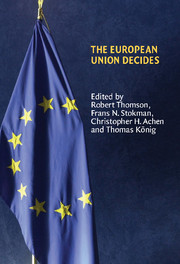Book contents
- Frontmatter
- Contents
- List of figures
- List of tables
- Notes on contributors
- Preface
- 1 Explaining legislative decision-making in the European Union
- 2 Research design: measuring actors' positions, saliences and capabilities
- 3 Testing procedural models of EU legislative decision-making
- 4 Institutional realism and bargaining models
- 5 Compromise, exchange and challenge in the European Union
- 6 Nash versus Schelling? The importance of constraints in legislative bargaining
- 7 A cooperative approach to decision-making in the European Union
- 8 A procedural exchange model of EU legislative politics
- 9 Beyond informal compromise: testing conditional formal procedures of EU decision-making
- 10 Evaluating political decision-making models
- 11 Evidence with insight: what models contribute to EU research
- Appendix I Selection of Commission proposals
- Appendix II Comparison of expert judgements with each other and with information from Council documentation
- References
- Index
- Title in this series
5 - Compromise, exchange and challenge in the European Union
Published online by Cambridge University Press: 22 September 2009
- Frontmatter
- Contents
- List of figures
- List of tables
- Notes on contributors
- Preface
- 1 Explaining legislative decision-making in the European Union
- 2 Research design: measuring actors' positions, saliences and capabilities
- 3 Testing procedural models of EU legislative decision-making
- 4 Institutional realism and bargaining models
- 5 Compromise, exchange and challenge in the European Union
- 6 Nash versus Schelling? The importance of constraints in legislative bargaining
- 7 A cooperative approach to decision-making in the European Union
- 8 A procedural exchange model of EU legislative politics
- 9 Beyond informal compromise: testing conditional formal procedures of EU decision-making
- 10 Evaluating political decision-making models
- 11 Evidence with insight: what models contribute to EU research
- Appendix I Selection of Commission proposals
- Appendix II Comparison of expert judgements with each other and with information from Council documentation
- References
- Index
- Title in this series
Summary
INTRODUCTION
According to the account of European Union (EU) decision-making proposed in this chapter, this is a bargaining process during which actors shift their policy positions with a view to reaching agreements on controversial issues. Formal institutions, such as the procedural rules explored in Chapter 3, matter in this process. They define the set of actors included in the process and their relative weight or power. The observation that actors shift their positions, and cajole or compel others to shift theirs, is central to our conception of political bargaining. Practitioners of European affairs reported that flexibility in actors' initial policy positions is an important feature of the decision-making process. During one interview an informant was asked why the actors were so polarised in terms of the policy alternatives they ‘favoured most’ at the outset of the discussions. He responded: ‘That's not so unusual. At the start of the negotiations, the positions tend to be more extreme. As the discussions get underway, we realise what is politically feasible, and converge gradually toward those points’. In this chapter, we compare two different models of the bargaining process in which actors shift from the policy positions they favour most at the outset of the discussions.
The models we focus on in this chapter are the position exchange model (Stokman and Van Oosten 1994) and the challenge model (in other studies this model is also referred to as ‘the expected utility model’, Bueno de Mesquita 1994).
- Type
- Chapter
- Information
- The European Union Decides , pp. 124 - 152Publisher: Cambridge University PressPrint publication year: 2006
- 19
- Cited by



